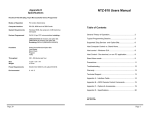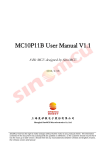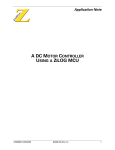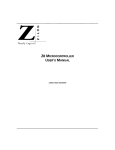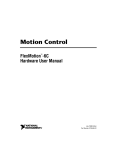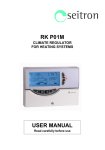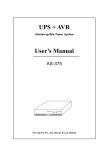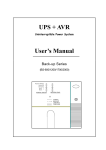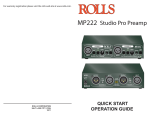Download PDF document - Eetasia.com
Transcript
APPLICATION NOTE 1 ANALOG-TO-DIGITAL CONVERSION TECHNIQUES USING ZILOG Z8® MCUS A SEPARATE ADC CHIP ISN’T ALWAYS NECESSARY. MANY APPLICATIONS REQUIRING A/D CONVERSIONS CAN BE ACHIEVED WITH 8-BIT MCUS— AND WITHOUT COMPROMISING ACCURACY, SPEED, OR SYSTEM COST. INTRODUCTION Many embedded controller applications require an analog voltage to be captured. Depending on the application, a separate A/D converter (ADC) chip may be necessary because of the speed and resolution requirements. However, many designs do not need fast conversion speeds, and 8 bits of resolution is adequate. For instance, a digital thermostat samples the temperature periodically and turns the heater or air conditioner on or off when the temperature hits a trip point. Here, the measurement speed for the voltage across a thermistor is not critical since the temperature is changing rather slowly. In this case, conversion times on the order of milliseconds are acceptable. Capturing fast-changing signals, such as audio, requires a much faster conversion rate. If the highest audio frequency is 4 kHz coming into the ADC, the sample rate should be at least twice this (8 kHz). Because of the limited processing time in between samples (in this case 125 µs), the ADC must do a conversion quickly, so the MCU has time to process the data before the next sample. Since most designs are cost-sensitive—especially in consumer electronics—there may not be the luxury of adding relatively expensive ADC chips to the design. Design engineers must look for a more integrated solution, and Zilog has the solution. ZILOG Z8 MCU FEATURES Zilog Z8® microcontrollers (MCUs) to which the following A/D conversion techniques apply range in package sizes from 18 to 44 pins. ROM sizes vary from 0.5 to 4 KB. These are available in masked and OTP configurations, and can be clocked up to 12 MHz using a RC, LC, ceramic resonator, or crystal oscillator (refer to Table 1). ■ Two power-down modes are available: HALT and STOP. The block diagram of a typical Z8 architecture is shown in Figure 1. Selected Zilog MCUs are shown in Table 1. ■ STOP completely shuts down the chip, including the oscillator. To come out of STOP mode, you apply a positive- or negative-going edge to one of the external digital inputs or via the internal Watch-Dog Timer (WDT). This application is set up via the Stop-Mode Recovery (SMR) register. HALT freezes code execution, but leaves the timers enabled. The processor can exit HALT via an external or internal interrupt. AP97Z8X0901 1 Application Note Analog-to-Digital Conversion Techniques Using Zilog Z8® MCUs Zilog Figure 1. Typical Z8 MCU Block Diagram 2 AP97Z8X0901 Application Note Analog-to-Digital Conversion Techniques Using Zilog Z8® MCUs Zilog Table 1. Selected List of Zilog Z8 MCUs Product Pin Family Count ROM (KB) RAM (Bytes) I/O Speed (MHz) 1 Package Type Z86C03 18 0.5 64 14 8 DIP, SOIC Z86E03 18 0.5 64 14 8 DIP, SOIC Z86C04 18 1 128 14 8 DIP, SOIC Z86E04 18 1 128 14 8 DIP, SOIC Z86C06 18 1 128 14 4, 12 DIP, SOIC Z86E06 18 1 128 14 4, 12 DIP, SOIC Z86C07 18 2 128 14 8, 12 DIP, SOIC Z86E07 18 2 128 14 8, 12 DIP, SOIC Z86C08 18 2 128 14 4, 12 DIP, SOIC Z86E08 18 2 128 14 4, 12 DIP, SOIC Z86C09 18 2 125 14 12 DIP, SOIC Z86C16 18 1 128 14 8 DIP, SOIC Z86C19 18 4 125 14 12 DIP, SOIC Z86C30 28 4 256 24 12 DIP, SOIC Z86E30 28 4 256 24 12 DIP, WIN Z86C31 28 2 128 24 8 DIP DIP Z86E31 28 2 128 24 8 Z86C32 28 2 237 24 4, 8 DIP, SOIC Z86C40 40/44 4 256 32 4, 12 DIP, PLCC, QFP Z86E40 40/44 4 256 32 12 DIP, PLCC, QFP Note: Masked ROM versions are indicated with the letter “C” (Z86C03, for example); OTP versions are indicated with the letter “E” (Z86E03, for example). AP97Z8X0901 3 Application Note Analog-to-Digital Conversion Techniques Using Zilog Z8® MCUs 4 Zilog AP97Z8X0901 Application Note Analog-to-Digital Conversion Techniques Using Zilog Z8® MCUs Zilog The on-board dual analog comparators, along with one counter/timer, will be used to implement the ADC routines. The analog comparators are multiplexed with the digital inputs on port pins P31, P32, and P33. This is depicted in Figure 2. The analog comparators are selected via the P3M register. The comparators share a common reference pin, P33. The input range of the comparators is 0-4V. The input offset voltage is typically 10 mV with Vcc at 5.0V. The output of the comparators may be examined by a TM instruction (Test under Mask) on port P3. The outputs also generate an interrupt, based on the falling or rising edge of the comparator output. These outputs also can connect to the P34 and P37 output pins under software control. The PCON register in the extended register file controls this connection (not available on C04/E04 and C08/E08). The comparators are enabled during HALT mode, but are disabled in STOP mode. Three ADC configurations will be presented: ■ PWM Ramp ADC ■ Successive Approximation ADC ■ RC Ramp ADC R247 = P3M D1 1 = Analog 0 = Digital DIG. P31 (AN1) + - P32 (AN2) P33 (REF) + - IRQ. 2,TIN, P31 Data Latch AN. IRQ. 0,P32 Data Latch IRQ. 1,P33 Data Latch From Stop-Mode Recovery Source Figure 2. Port 3 Configuration The software routines were designed around the Z86C04/E04, but can be adapted for other selected Z8 MCUs. AP97Z8X0901 The Zilog CCP emulator (Zilog PN Z86CCP00ZEM) was used to test the routines . These routines are designed to be “generic” in nature, meaning that they can be used with other Z8 MCUs. 5 1 Application Note Analog-to-Digital Conversion Techniques Using Zilog Z8® MCUs Zilog PWM RAMP ADC Figure 3 depicts a Pulse-Width Modulated (PWM) ramp and timer to implement a single-slope ADC. This method has the advantage of being interrupt-driven, so that the processor can perform other tasks while doing a conversion. The conversion time, however, is usually in the tens of milliseconds. Here, a fixed-frequency square wave of variable duty cycle begins at a low value and is steadily increased by incrementing the timer count at the end of each sample period. Generate the ramp by incrementing Timer 1’s value after each sample period. Incrementing the count from 1 (01H) to 200 (C8H) resets the ramp. The value loaded into the register called DELAY determines the sample period. The conversion speed is determined by the speed of the system clock, the analog-input voltage range, sample frequency, and the resolution of the timer. In this example, the crystal frequency is 8 MHz, the input voltage range is 0–4V, the sampling frequency is about 4800 kHz, and the resolution is 8-bits. This will yield a maximum conversion time of 40 ms. The PWM output, (P00), is fed to a RC integrator, which produces a linear ramp at the VREF input of the comparators at P33. Two analog voltages can be measured concurrently using this technique.The analog voltages to be measured are sensed at P31 and P32. The voltage range at these inputs is 0–4V. If you know that the input voltage range is from 2–4V, then you can restrict the ramp voltage to this range, which yields a faster conversion time. Also, if 8-bits of resolution is overkill, then adding two counts to the timer at the end of each sample period will result in 7 bits of resolution. Adding four counts yields 6 bits. Refer to Code Listing 1 at the conclusion of this application note, which shows the single-slope software routine. Each comparator has its own interrupt level. When the positive-going ramp exceeds the input voltage, the corresponding interrupt will then load the contents of the timer, which is scaled to the measured analog input. 100K 11 P00 .1µF Z86C03 Analog IN 8 P31 Analog IN 9 10 P32 P33 5 +5 + - + - GND Vcc 14 + 10 µF XTAL1 7 XTAL2 6 8 MHz 27pF 27pF Figure 3. Single Slope ADC Using PWM Ramp 6 AP97Z8X0901 Application Note Analog-to-Digital Conversion Techniques Using Zilog Z8® MCUs Zilog SUCCESSIVE APPROXIMATION ADC For applications requiring faster conversion times, you want to consider the successive approximation method (see Figure 4). This routine, however, cannot be used in background mode, which means that when a conversion is taking place, the processor must drop what it’s doing and call or jump to this routine. However, at the end of a conversion, it can then continue where it left off. This method uses a Digital-to-Analog Converter (DAC) in its feedback loop. The DAC is comprised of an R2R ladder connected to port P2. When a binary value is output at Port 2, a DC voltage proportional to the binary value appears at pin 1 of the ladder network. The DAC does a binary search on the input voltage. This is achieved by first setting the most significant bit (MSB) of the DAC and testing the comparator output. If the comparator output is zero, then the DAC output for this bit is set to zero. If the comparator output is one, then the DAC output for this bit is set to one. The bits from the output port 2 are individually tested in descending order, performing the same test. When all the bits have been tested, the conversion is complete. The output from the R2R resistor network becomes the comparator's reference voltage. The analog voltage to be measured can be connected to either P31 or P32, the non-inverting inputs of the comparators. The software for this routine is shown in Code Listing 2. To start the conversion, the MSB of P2 is set, resulting in a voltage of half of VCC at the VREF input of the comparator. If VCC is 5V, then this will be 2.5V. The non-inverting comparator input is then tested. If High, then the analog voltage must be 2.5V–5.0V. The next bit, P26, is then set, and the input port is tested again. If Low, then this bit is reset. The process continues until all bits of P2 have been tested. The resultant value at P2 is the digital representation of the analog input. With a crystal frequency of 12 MHz, the conversion time is approximately 70 µs. Even more resolution is available from 10- and 12-bit R2R networks. Of course, more port pins are then needed. If a track-and-hold function is desired, analog switch CD4016 can be added to the front end. In between samples, the switch is closed, charging a small capacitor. At the end of each sample period—as determined by timer T1—the switch is opened. Any error induced by trying to convert a fast-changing analog input is eliminated. The value of C is chosen so that the voltage across it tracks the input voltage, does not bleed off during the conversion, and follows the input voltage in between samples. For a sampling rate of 8 kHz, the input frequency must be less than or equal to 4 kHz to prevent distortion due aliasing. Bourns 4610X-R2R-103 Optional Track-and-Hold P27 26 P00 P26 13 Z86C40 ANALOG IN 1 16 P31 2 33pF 17 18 P32 P33 CD4016 P25 + + - 11 + 10 µF 31 GND XTAL1 27pF 3 2 4 6 37 7 36 8 35 9 P20 XTAL2 1 20K 38 P21 15 12 MHz 3 5 P23 Vcc 2 P24 39 P22 +5V 4 14 10K 10 27pF Figure 4. Successive Approximation ADC AP97Z8X0901 7 1 Application Note Analog-to-Digital Conversion Techniques Using Zilog Z8® MCUs Zilog RC RAMP ADC a counter tick period of 1 ms when the prescaler is set to divide-by-1. When the capacitor voltage at P31 crosses the unknown analog voltage at P33, the comparator will switch, causing the counter/timer T1 to stop. For cost-sensitive applications, consider the low-cost technique that is shown in Figure 5. Since this method uses a logarithmic RC ramp for the comparator reference voltage, the A/D result will not be a linear function of the input analog voltage. For many applications, such as some battery chargers and peak detection circuits, linearity is not essential. If necessary, software compensation by look-up table can be used to linearize the A/D result. Code Listing 3 (at conclusion of this application note) shows the routine, which gives a resolution of 8 bits and a maximum conversion time of 256 µs for an oscillator frequency of 8 MHz. The accuracy is ± LSB. If the oscillator frequency is changed, the RC values will need adjustment. The analog input voltage range is 0–4V. This method uses an externally generated RC ramp and a counter/timer to measure the analog voltage at comparator input P33. The RC ramp is limited to the 4V common mode range of the Z8 comparator. The C1 capacitor is readied for conversion by briefly setting output P00. The C1–P31 node will discharge to 4V, as determined by the R1–R2 voltage divider. When conversion is started, P00 is taken Low so that the C1–P31 node charges toward ground through the parallel combination of R1 and R2. Some applications require accurate detection of a single threshold level. RC value tolerances can be adjusted out with the addition of a single calibration. Simply replace R2 with a potentiometer and series resistor. Calibration is performed by putting the desired threshold voltage at P33 while adjusting the pot for desired result. Use a temperature stable capacitor, such as a ceramic NPO type, if wide temperature variations are expected. At the same time the ramp is initiated, counter/timer T1 is started in gate mode. A crystal frequency of 8 MHz will give +5V Vcc C1 10µF Analog Voltage IN + C2 10µF Z86C04 10 P33 8 P31 R1 100K + R2 22K P00 XTAL1 7 XTAL2 8 MHz 6 27pF 27pF Figure 5. A/D Converter Using RC Ramp 8 AP97Z8X0901 Zilog Application Note Analog-to-Digital Conversion Techniques Using Zilog Z8® MCUs CONCLUSION REFERENCE You can see from the previous examples that applications requiring analog-to-digital conversions can be achieved without compromising accuracy, speed, or system cost. Design engineers can experiment with the routines for optimum performance. These routines are designed to be functions called from the main program; however, it is possible to modify the program so that it is completely interrupt-driven. This change allows the MCU to handle other tasks in between the timer and comparator interrupts. By adding a software UART routine to the above programs, you can implement a truly low-cost, PC-compatible data acquisition system. 1. Ciarcia, S., “Analog Interfacing In The Real World,” Ciarcia’s Circuit Cellar, Vol. IV, 1984. AP97Z8X0901 1 1. Distaso, L.A., “Analog to Digital Conversion Techniques With COPS Family Microcontrollers”, National Semiconductor Corp., National Semiconductor Microcontroller Databook, 1987. 2. Zilog, Zilog Discrete Z8 Microcontroller Product Specification Databook, DC 8318-02, Q3 1994. 3. Zilog, Zilog Z8 Microcontrollers User's Manual, UM95Z8000103, 1995. 9 Application Note Analog-to-Digital Conversion Techniques Using Zilog Z8® MCUs Zilog CODE LISTING 1 ;*********************************************************************************************** ; SINGLE-SLOPE SOFTWARE ROUTINE ; ; The PWM-generated ramp ADC uses two timers and counters and an RC integrator to find the ; unknown input voltage. When the ramp voltage exceeds VIN, an interrupt is generated. The ; value in timer T1 is the digital representation of this voltage. ;************************************************************************************************ delay_hi .equ r4 delay_lo .equ r5 delay .equ rr4 count .equ r6 irq_0 .equ 1 .org 0 .word .word .word .word .word .word comp_trip 0 0 0 timer_0 timer_1 .org 0ch di ; disable interrupts srp #0 ; set reg pointer 0-15h ld spl,#80h ; set stack pointer at top of stack ld p01m,#4 ; internal stack ld p3m,#3 ; active pull-ups on p2, comp on ld p2m,#0ffh ; inputs on p2 ld pre0,#04h ; divide by one, one-shot clr t0 ; t0 sets the sample period ld pre1,#06h ; divide by one, one-shot mode ld count,#4 ; start counter with minimum count ld t1,count ; load counter ld p0,#04h ; take port pin P02 high to start ld imr,#31h ; load interrupt mask register clr irq ; clear interrupt request reg clr ipr ; clear interrupt priority reg ld tmr,#0fh ; load and enable both counters wait_here: ei ; enable interrupts jr wait_here ; wait for interrupts ;------------------------------------------------------------------------------------------------; Timer 0 interrupt routine. Here, the count is incremented every 1000 µs, until a maximum ; count of 240 is reached. The count is then reset, and the integrating capacitor discharges. ; Port pin P00 is then taken high, and the timers are reloaded and enabled. ;------------------------------------------------------------------------------------------------timer_0: inc count ; start with min count cp count,#240 ; max count? jr ult,continue ; if not maximum, reload timer ld count,#4 ; load count with initial value delay_loop: decw delay ; let cap discharge jr nz,delay_loop ; wait awhile continue: ld t1,count ; load timer with count or p0,#04h ; take p02 high or tmr,#0fh ; load and enable t1 iret ; return from interrupt 10 AP97Z8X0901 Application Note Analog-to-Digital Conversion Techniques Using Zilog Z8® MCUs Zilog ;------------------------------------------------------------------------------------------------; Timer 1 interrupt routine. Port pin P00 is toggled low.This sets the duty cycle for the PWM. ;------------------------------------------------------------------------------------------------timer_1: xor p0,#04h ; take p02 low iret ; return from interrupt ;------------------------------------------------------------------------------------------------; Comparator interrupt routine. When the ramp voltage at P33 exceeds the input voltage, the ; program vectors here. The value in register called count is proportional to the input ; voltage. ;----------------------------------------------------------------------comp_trip: jr comp_trip ; stop here .end 1 CODE LISTING 2 ;************************************************************************************************* ; SUCCESSIVE APPROXIMATION ADC ROUTINE ; ; The successive-approximation ADC uses an R2R ladder connected to an output port. The software ; performs a binary search on the input voltage. At the end of the conversion, P2 contains ; the digital representation of the input voltage. ;************************************************************************************************* test_p32 .equ r4 ring .equ r5 results .equ r6 .org 0h .word .word .word .word .word .word 0 0 0 0 0 0 .org init: next_bit: EOC: AP97Z8X0901 di ld ld ld ld srp ld clr clr scf rrc jr or nop tm jr xor jr ld jr .end 0ch spl,#80h p01m,#4 p3m,#3 p2m,#00 #0 test_p31,#01h p2 ring ring c,EOC p2,ring p3,test_p32 nz,next_bit p2,ring next_bit results,p2 EOC ; disable interrupts ; set stack at top of reg file ; set for internal stack ; active on p2, turn on comp ; p2 all outputs ; set pointer to bottom of reg file ; test comparator with working reg ; start out at zero ; reset ring register ; set carry flag ; rotate a one through ring reg ; end of conversion if a carry ; set P2 bit ; let it settle ; test p32 input ; if not low, set next bit ; reset bit if it went low ; continue ; gets results ; loop here when done 11 Application Note Analog-to-Digital Conversion Techniques Using Zilog Z8® MCUs Zilog CODE LISTING 3 ;************************************************************************************************* ; RC RAMP ADC ; ; This routine uses an externally generated ramp and a counter timer to measure the voltage ; at comparator input P33. This routine gives a resolution of 8 bits and a maximum conversion ; time of 256 µs for an oscillator frequency of 8 MHz. ;************************************************************************************************* result .equ r4 delay .equ r5 irq2 start: delay_loop: poll_irq2: conversion_done: 12 .equ 4 .org 0 ; start of interrupt vector table .word .word .word .word .word .word 0 0 0 0 0 0 ; ; ; ; ; ; .org 0ch ; start code execution here di srp ld ld ld ld ld clr clr clr clr clr ld clr djnz clr or ei tm jr ld com jr .end? #0 spl,#80h p01m,#4 p3m,#3 p2m,#00h pre1,#06h t1 tmr imr irq ipr p0,#02h delay delay,delay_loop p0 tmr,#0ch irq,#irq2 z,poll_irq2 result,t1 result conversion_done ; ; ; ; ; ; ; ; ; ; ; ; ; ; ; ; ; ; ; ; ; ; ; interrupt interrupt interrupt interrupt interrupt interrupt 0 1 2 3 4 5 vector vector vector vector vector vector address address address address address address disable interrupts set reg pointer 0-15h set stack pointer at top of stack internal stack pull-ups on p2, comparators on outputs on p20-p27 divide by one, one-shot mode clear timer timer 1 off clear interrupt mask reg clear interrupt request reg clear interrupt priority reg discharge cap load delay with discharge delay wait until cap discharged take p20 low (start ramp) load and start timer enable interrupts test for comparator trip (irq2) if not set, continue polling get count from t1 compliment loop here when done AP97Z8X0901 Zilog Application Note Analog-to-Digital Conversion Techniques Using Zilog Z8® MCUs © 1997 by Zilog, Inc. All rights reserved. No part of this document may be copied or reproduced in any form or by any means without the prior written consent of Zilog, Inc. The information in this document is subject to change without notice. Devices sold by Zilog, Inc. are covered by warranty and patent indemnification provisions appearing in Zilog, Inc. Terms and Conditions of Sale only. Zilog, Inc. makes no warranty, express, statutory, implied or by description, regarding the information set forth herein or regarding the freedom of the described devices from intellectual property infringement. Zilog, Inc. makes no warranty of merchantability or fitness for any purpose. Zilog, Inc. shall not be responsible for any errors that may appear in this document. Zilog, Inc. makes no commitment to update or keep current the information contained in this document. AP97Z8X0901 Zilog's products are not authorized for use as critical components in life support devices or systems unless a specific written agreement pertaining to such intended use is executed between the customer and Zilog prior to use. Life support devices or systems are those which are intended for surgical implantation into the body, or which sustains life whose failure to perform, when properly used in accordance with instructions for use provided in the labeling, can be reasonably expected to result in significant injury to the user. Zilog, Inc., 210 East Hacienda Ave. Campbell, CA 95008-6600 Telephone (408) 370-8000 FAX (408) 370-8056 BBS (408) 370-8024 Internet: http://www.zilog.com 13 1 Application Note Analog-to-Digital Conversion Techniques Using Zilog Z8® MCUs 14 Zilog AP97Z8X0901














